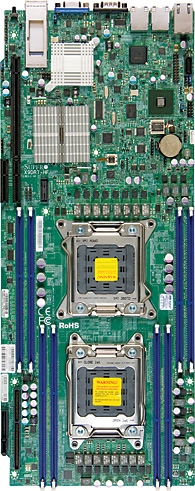The Xeon E5-2600: Dual Sandy Bridge for Servers
by Johan De Gelas on March 6, 2012 9:27 AM EST- Posted in
- IT Computing
- Virtualization
- Xeon
- Opteron
- Cloud Computing
Supermicro's Latest Twin
We got a sneak peak at the Supermicro's brand new Twin 2U server: the SYS-6027TR-D71FRF. The 2U chassis has two dual Xeon E5 based servers inside that are fed by two fully redundant 1280W PSUs (at 180-230V, 1000W at 100-140V).
The two servers are held in place using screwless clips.
You get the density of a 1U server without needing four PSUs for redundancy and without the very power hungry 40 mm fans. Indeed, using only 2 PSUs and 80 mm fans should save quite a bit of power compared to 2 1U servers. Last time we measured, the Twin servers consumed 6% less power than the best 1U servers on the market.
At the same time, the expansion capabilities are better: you get two full height and one half height PCIe 3.0 (!) x16 (x8 electrical) slots. The only disadvantage is that you only get 4 DIMM slots per CPU, which generally limits each server to about 128 GB of RAM (8 x 16 GB) unless you go with expensive 32 GB LR-DIMMS for a total of 256 GB. Therefore this server is probably better for HPC workloads than for memory intensive virtualization and database applications.
This new Twin server also features FDR InfiniBand interconnect technology, good for 56Gb/s (!) low latency network connections with an X4 cable. This should work especially well in tandem with Intel Data Direct I/O technology, where packets are directly transferred into the Last Level Cache (LLC) instead of being DMAed to the memory. This is something we'll be investigating in a later article.














81 Comments
View All Comments
alpha754293 - Tuesday, March 6, 2012 - link
Thanks for running those.Are those results with HTT or without?
If you can write a little more about the run settings that you used (with/without HTT, number of processes), that would be great.
Very interesting results thought.
It would have been interesting to see what the power consumption and total energy consumption numbers would be for these runs (to see if having the faster processor would really be that beneficial).
Thanks!
alpha754293 - Tuesday, March 6, 2012 - link
I should work with you more to get you running some Fluent benchmarks as well.But, yes, HPC simulations DO take a VERY long time. And we beat the crap out of our systems on a regular basis.
jhh - Tuesday, March 6, 2012 - link
This is the most interesting part to me, as someone interested in high network I/O. With the packets going directly into cache, as long as they get processed before they get pushed out by subsequent packets, the packet processing code doesn't have to stall waiting for the packet to be pulled from RAM into cache. Potentially, the packet never needs to be written to RAM at all, avoiding using that memory capacity. In the other direction, web servers and the like can produce their output without ever putting the results into RAM.meloz - Tuesday, March 6, 2012 - link
I wonder if this Data Direct I/O Technology has any relevance to audio engineering? I know that latency is a big deal for those guys. In past I have read some discussion on latency at gearslutz, but the exact science is beyond me.Perhaps future versions of protools and other professional DAWs will make use of Data Direct I/O Technology.
Samus - Tuesday, March 6, 2012 - link
wow. 20MB of on-die cache. thats ridiculous.PwnBroker2 - Tuesday, March 6, 2012 - link
dont know about the others but not ATT. still using AMD even on the new workstation upgrades but then again IBM does our IT support, so who knows for the future.the new xeon's processors are beasts anyways, just wondering what the server price point will be.
tipoo - Tuesday, March 6, 2012 - link
"AMD's engineers probably the dumbest engineers in the world because any data in AMD processor is not processed but only transferred to the chipset."...What?
tipoo - Tuesday, March 6, 2012 - link
Think you've repeated that enough for one article?tipoo - Wednesday, March 7, 2012 - link
Like the Ivy bridge comments, just for future readers note that this was a reply to a deleted troll and no longer applies.IntelUser2000 - Tuesday, March 6, 2012 - link
Johan, you got the percentage numbers for LS-Dyna wrong.You said for the first one: the Xeon E5-2660 offers 20% better performance, the 2690 is 31% faster. It is interesting to note that LS-Dyna does not scale well with clockspeed: the 32% higher clockspeed of the Xeon E5-2690 results in only a 14% speed increase.
E5-2690 vs Opteron 6276: +46%(621/426)
E5-2660 vs Opteron 6276: +26%(621/492)
E5-2690 vs E5-2660: +15%(492/426)
In the conclusion you said the E5 2660 is "56% faster than X5650, 21% faster than 6276, and 6C is 8% faster than 6276"
Actually...
LS Dyna Neon-
E5-2660 vs X5650: +77%(872/492)
E5-2660 vs 6276: +26%(621/492)
E5-2660 6C vs 6276: +9%(621/570)
LS Dyna TVC-
E5-2660 vs X5650: +78%(10833/6072)
E5-2660 vs 6276: +35%(8181/6072)
E5-2660 6C vs 6276: +13%(8181/7228)
It's funny how you got the % numbers for your conclusions. It's merely the ratio of lower number vs higher number multiplied by 100.